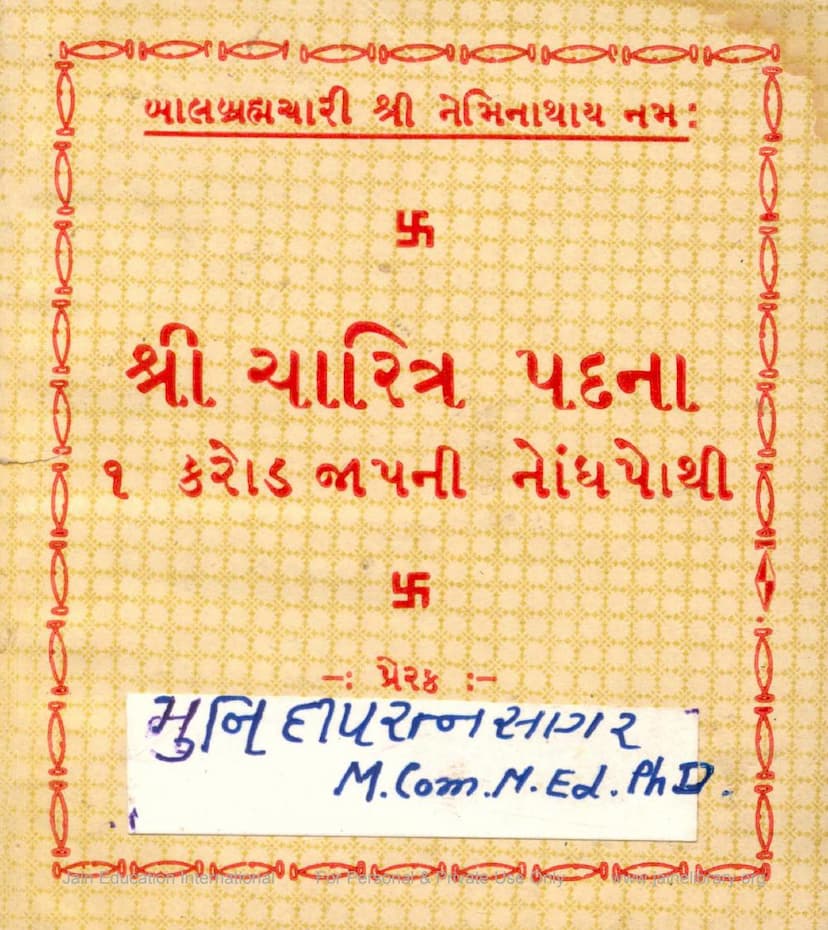Charitra Padna 1 Karod Jaapni Nondh Pothi
Added to library: September 1, 2025

Summary
Here's a comprehensive summary of the provided Jain text, "Charitra Padna 1 Karod Jaapni Nondh Pothi" by Dipratnasagar and Deepratnasagar:
Book Title: Charitra Padna 1 Karod Jaapni Nondh Pothi (A Record Book for Chanting the 'Charitra Pad' One Crore Times)
Author(s): Dipratnasagar, Deepratnasagar
Publisher: Deepratnasagar
Overview:
This book is essentially a specialized journal or logbook designed for Jains who wish to undertake a rigorous practice of chanting the "Charitra Pad" (the principle or essence of Right Conduct) one crore (ten million) times. The preface and introductory pages explain the profound spiritual significance and the reasons behind undertaking such a dedicated devotional practice. The majority of the provided pages are blank, structured for the user to record their progress in chanting.
Key Themes and Purpose of Chanting 'Charitra Pad':
The text outlines several compelling reasons why a Jain practitioner would undertake the extensive chanting of "Charitra Pad":
-
Attainment of Kshāyik Charitra (Kshāyik Right Conduct): The primary goal is to achieve "Kshāyik Charitra," the highest and most purified form of Right Conduct, which is a state of complete eradication of passions and karmic bondage.
-
Strengthening Dravya and Bhāv Charitra: Even if Kshāyik Charitra is not immediately attained, the chanting is intended to reinforce and strengthen the existing "Dravya Charitra" (external observances and rituals) and "Bhāv Charitra" (internal spiritual disposition and intentions).
-
Eradication of Kashāyas (Passions): The chanting is a practice aimed at destroying the four core Kashāyas: anger (Krodh), pride (Maan), deceit (Maya), and greed (Lobh).
-
Overcoming Nokashāyas (Subtle Passions): It also addresses the elimination of "Nokashāyas," which are subtler forms of negative emotions like laughter (Haasya), attachment (Rati), aversion (Arati), fear (Bhaya), sorrow (Shok), disgust (Jugupsa), and the three types of sexual disposition (Purush-ved, Stri-ved, Napunsak-ved). These are seen as the root cause of endless cycles of rebirth and suffering in the worldly existence (Samsara).
-
Attainment of Kshāyik Darshan and Kshāyik Gyan: The text emphasizes that achieving Kshāyik Charitra is only possible when one has also attained "Kshāyik Darshan" (Pure Right Perception) and "Kshāyik Gyan" (Pure Right Knowledge). Therefore, the chanting is undertaken to facilitate the attainment of the "Tattvatrayi" (the triad of Right Faith, Right Knowledge, and Right Conduct).
-
Attainment of Eternal Bliss: The fundamental Jain belief that liberation (Mukti) is impossible without Right Conduct is highlighted. Without liberation, the soul remains trapped in suffering. Thus, the chanting is done to attain eternal happiness, peace, and bliss.
-
Exhaustion of Charitra Mohaniya Karma: The practice is specifically aimed at exhausting "Charitra Mohaniya Karma," the karmic matter that obscures and obstructs Right Conduct.
-
Cultivating Renunciation and Restraint: The text acknowledges the difficulty of cultivating an attitude of renunciation and performing vows (Pachakkhan) for the cessation of sins. The chanting is intended to help the practitioner engage with this form of Dharma (religious practice), which involves both activity (Pravrutti) and cessation (Nivritti).
-
Respect and Service towards Monks: The practice fosters an attitude of respect and diligent service (Vaiyavachcha) towards those who have taken monastic vows, as well as those who aspire to it. This includes offering service with joy and dedicating the merit of such service.
-
Preventing Disrespect towards Monks: The chanting is also undertaken to counteract any tendency towards disrespect, disregard, or disapproval of those who have embraced the path of monasticism. It aims to purify the mind of any negative sentiments or actions that might disrespect the spiritual path.
Structure of the Record Book:
The book is designed with a structured format to track the progress of the one-crore chantings. It features:
- Space for Daily/Regular Entries: The majority of the book consists of numbered pages with sections for recording each chanting session.
- Counting Mechanism: The text explains a method for counting: completing 10 "Malas" (rounds of chanting a specific mantra) fills one box. Filling 10,000 boxes equates to completing one lakh (100,000) malas, and consequently, a crore (10,000,000) malas when 100 such sets are completed. The book contains 10,000 boxes.
- Purpose of the Logbook: The author, Muni Deepratnasagar, explains that this meticulously prepared logbook was created because previously available records were not sufficiently systematic. He expresses his hope that by using this organized logbook, practitioners will successfully complete their one-crore chantings and achieve Kshāyik Charitra.
Author's Works:
The latter pages highlight Muni Deepratnasagar's extensive literary contributions, which span various aspects of Jain philosophy, grammar, rituals, and devotional literature. This context underscores his dedication to promoting spiritual practices and disseminating Jain teachings through written works.
Overall Significance:
"Charitra Padna 1 Karod Jaapni Nondh Pothi" is a practical spiritual tool for Jains seeking to deepen their understanding and practice of Right Conduct. It provides a structured framework and motivational impetus for undertaking a significant devotional discipline aimed at spiritual purification and ultimate liberation, as taught within Jainism. The text emphasizes the interconnectedness of perception, knowledge, and conduct in the path to spiritual freedom.